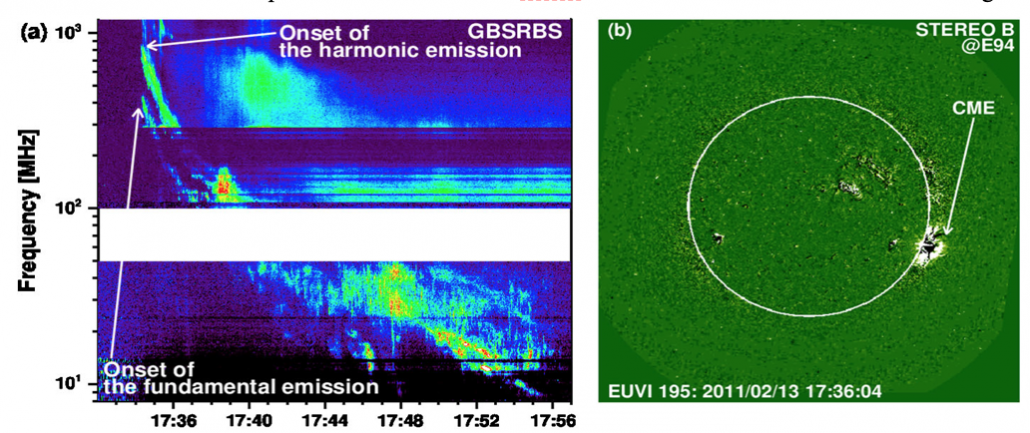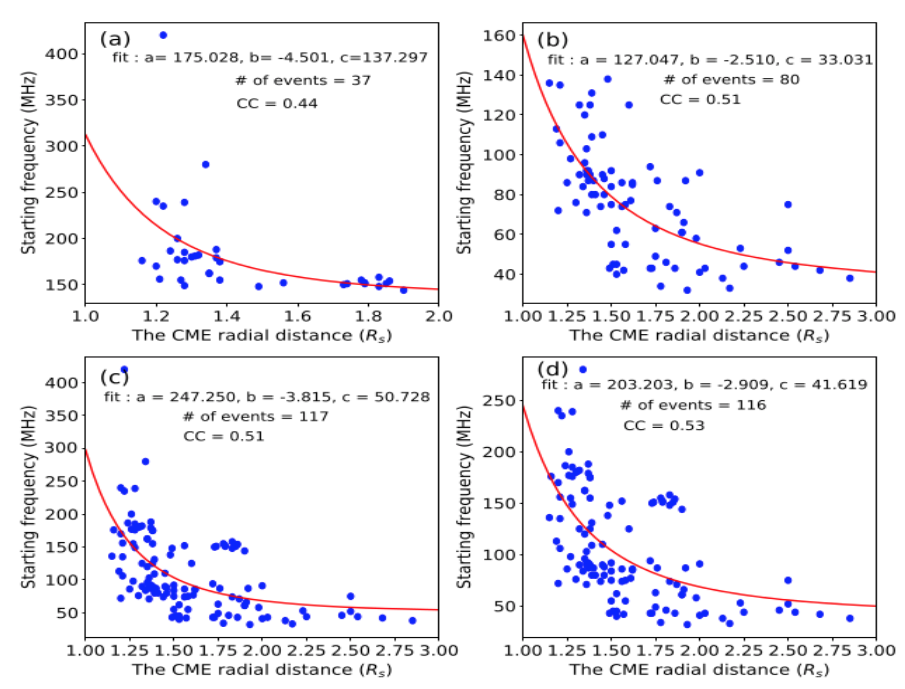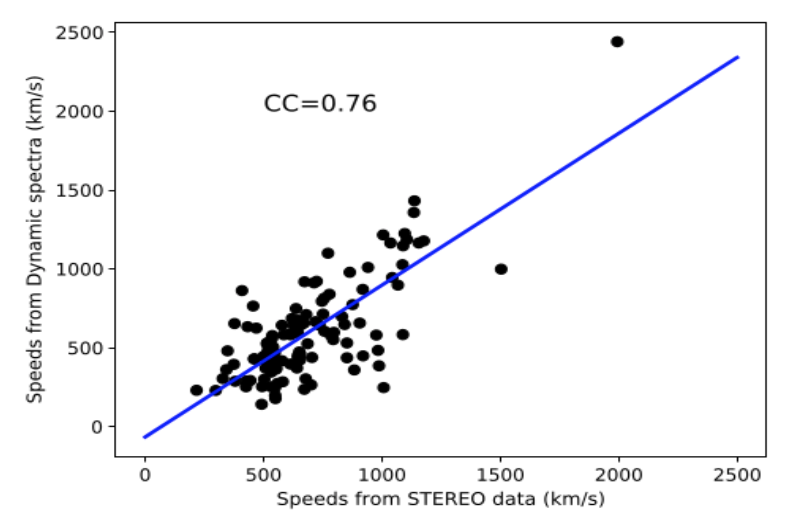Type II radio bursts are slow-drifting and long-lasting radio emission produced by nonthermal electrons accelerated at shocks propagating through the solar corona and interplanetary medium (Nelson & Melrose, 1985). The accelerated electrons generate Langmuir waves, which get converted into electromagnetic radiation by the plasma emission mechanism first identified by Ginzburg & Zhelezniakov (1958). Currently, there is a common understanding that type II radio bursts are produced by shocks formed ahead of Coronal Mass Ejections (CMEs) moving with super-Alfvénic speeds (Gopalswamy, et al., 2012). In this study, 128 type II bursts are analyzed, with a special emphasis on the 40 high frequency bursts to check the drift–frequency relationship. Previous studies considered events with lower starting frequencies ($<$ 14 MHz), and upper starting frequency in metric domain $\sim 140$ MHz .
2. Data and methods
The metric type II bursts considered in this study occurred during the period from 2010 to 2016, in the weakly active Solar Cycle 24. We checked the occurrence of type II burst as reported on the website of the Space Weather Prediction Center and considered those which are having spectral data obtained by different ground-based radio spectrographs. For each type II burst, we identified the associated CME from STEREO and SOHO instruments that image in the corona in EUV and/or white light. By combining coronagraph and EUV images, we were able to track all CME sources to the solar surface. Figure 1 shows an example of a high-starting-frequency type II burst observed by the Green Bank Solar Radio Bursts (GBSRB) spectrometer and its associated CME observed by STEREO-B/EUVI instruments. The fundamental starting frequency of the type II burst in the dynamic spectrum was 420 MHz (f2) at 17:35:00 UT (t2). The ending frequency was 60 MHz (f1) at 17:40:30 UT (t1). The event was associated with a flare, which occurred at N20E04 on the solar disk (see Cho, et al., 2013, for details). The associated CME was at N20W90 in the STEREO-B EUVI field of view (FOV). The CME-driven shock was observed in EUV 64 seconds after the appearance of type II burst corresponding to a height of 1.22 Rs. The relationship between the starting frequency of type II bursts in Solar Cycle 24 with the corresponding CME shock height can be obtained using the procedure in Gopalswamy, et al. (2013)

Figure 1 – (a) A high-starting-frequency type II burst. The dynamic spectrum was obtained by the Green Bank Solar Radio Burst Spectrometer (GBSRBS). The fundamental starting frequency was 420 MHz at 17:35:00 UT. The high starting frequency implies the radio source closer to the solar surface, hence the associated CME originating in the lower corona. (b) STEREO-B/EUVI 195 Å difference image shown by white arrow. The time of the image in (b) is close to the starting time of the type II burst. STEREO-B was located at E94 at the time of the eruption.
3. Results and Conclusions
In this study, the high-starting-frequency events are associated with shocks closer to the surface. This may indicate propagation of the shock through a high-density magnetic structure. The shock heights of CMEs associated with low-frequency events are generally large, which confirms the results of the previous study by Gopalswamy, et al. (2013). The correlation coefficient between the average CME speeds from STEREO data and the speeds estimated from the dynamic spectra is 0.76 for all events and 0.77 by excluding the two outliers near v2 ∼ 1500 km/s. The obtained correlation is significant. The average width of CMEs in the LASCO FOV is 172o, which is greater than 46o obtained in Gopalswamy (2006). Since the width is proportional to the mass, this shows that analyzed CMEs associated with type IIs are wide and more energetic. Generally, many events are associated with M and C class flares. For CMEs associated with high-frequency type II bursts, 33 out of 40 are associated with highly energetic flares (M and X class flares), which is consistent with their speeds. Moreover, there is a clear increase in speed between the inner and outer corona as measured in the STEREO and LASCO FOVs, which shows that the CMEs accelerate at the appearance of the metric type II burst. This has implications for the behavior of drift rate spectrum of type II bursts (Gopalswamy, et al., 2012). For a few events, the shock speeds at the time of metric type II bursts are smaller than the calculated average speeds within the STEREO/COR1 and EUVI FOV, which shows that the CME reached the peak speed before the appearance of type II bursts.

Figure 2 – (a) Scatter plot between CME heights and the high-starting-frequency type II burst with a power-law fit to the data. (b) Scatter plot between CME heights and type II starting frequency for low-starting-frequency events. (c) Scatter plot between CME heights and the starting frequency of type II for all events (i.e., combined data of low- and high-starting-frequency type II bursts). The correlation coefficient (CC) is 0.51. Excluding the highest starting frequency (d), the correlation coefficient becomes 0.53.

Figure 3 – Scatter plot between speeds from STEREO data (v2) and the radio dynamic spectra (vDS). The correlation coefficient (cc) is 0.76. When we exclude the two outliers near v2∼1500 km/s, cc=0.77.
In this study, we found that closer to the solar surface, where type II emission frequency is high, the CME speed increases due to fast acceleration and starts to decrease in the IP medium, which shows the relationship between these deviations from the universal drift rate spectrum of type II bursts and CME speeds. The high-starting-frequency type II bursts have high drift rates and are associated with fast CMEs, which is consistent with the CME driving shock regardless of the spectral domain of type II bursts.
Based on the recent paper: A.C, Umuhire, et. al. Solar Physics, 296:27 (2021): Properties of High-Frequency Type II Radio Bursts and Their Relation to the Associated Coronal Mass Ejections, DOI: 10.1007/s11207-020-01743-8
Full list of Authors: A.C. Umuhire, N. Gopalswamy, J. Uwamahoro, S. Akiyama, S. Yashiro, P. Mäkelä.
References
Cho, K.-S et al., 2013. 2013ApJ…765..148C
Ginzburg, V & Zhelezniakov, V., 1958. 1958SvA…..2..653G
Gopalswamy, N., 2006. 2006JApA…27..243G
Gopalswamy, N et al., 2012. 2012SoPh..277..459G
Gopalswamy, N et al., 2013. 2013AdSpR..51.1981G
Nelson, G & Melrose, D., 1985. 1985srph.book..333N
